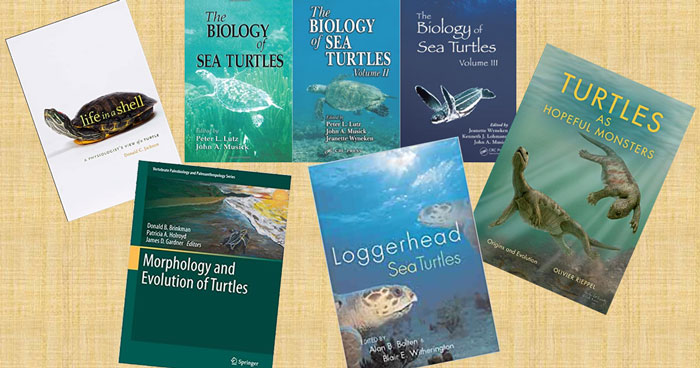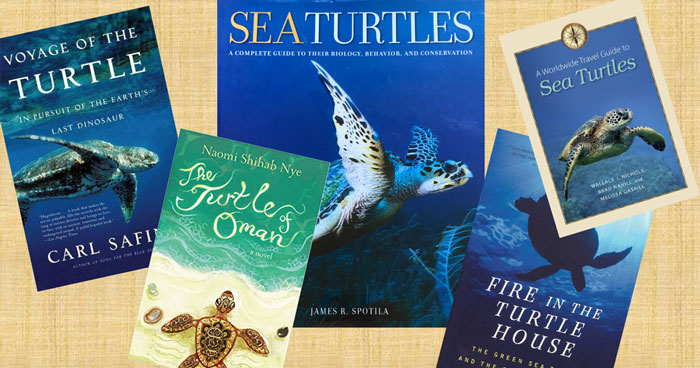
In this edition of the ORP Turtle Book Club we feature books for readers with a specific interest in the science surrounding turtles and their biology. Looking for a good book on sea turtle biology for a presentation at school? Working on a paper for comparative anatomy at uni? Wolfing down all the literature you can find surrounding your favourite animals? We have some great turtle science book recommendations for you!
The Biology of Sea Turtles Vol I-III
Written by Lutz, Musik & Wyneken (eds.)
Volume 1: 446 pages, first published 1997
Volume 2: 510 pages, first published 2002
Volume 3: 376 pages, first published 2012
Our Recommendation
These books are an important base and highly recommended for the library of any biologist aspiring or already working with sea turtles. It is a great source of first hand information and also a directory providing references for many further publications.
Published over the years, this short series provides very good baseline information on what we know about sea turtle biology and the research that was conducted about them.
Each book has multiple chapters touching on vital parts of all kinds of sea turtle science. Every chapter is written by one or several authors who focus their own research on the specific topic and provide a great review of the scientific literature currently dealing with it. For example, for information on population genetics, reproduction in sea turtles or Hatchling Orientation and Behaviour, you can consult the first book of the series.
In the second book, several chapters deal with human and turtle interactions in an historic and contemporary setting. A broad range from physiological studies investigating for example vision in turtles, as well as the effects of organic pollutants or the problem of age estimation in turtles are all addressed in the third book of the series.
Turtles as Hopeful Monsters: Origins and Evolution (Life of the Past)
Written by Olivier Rieppel
207 pages, first published 2017
Our Recommendation
Fascinating read binding together historical and modern research, highlighting the beauty that is inherent to these enigmatic shelled creatures. At times calling for the readers full and undivided attention, the book is well worth the read.
In ‘Turtles as Hopeful Monsters’ the author takes us on a journey both through the history of turtle evolution and the discovery and scientific concepts surrounding the topic.
Rieppel’s far-reaching style gives us a glimpse into the past on two levels. The first is to be expected by the book title, as it encompasses millions of years and focuses on the evolutionary origin of turtles. The second is a more recent part of our history. It discusses the development of hypotheses and theories around turtle evolution over many years of scientific discoveries.
On this journey through the scientific community since the 19th century, we learn about new fossil finds and how they were interpreted in the light of different evolutionary scenarios. New schools of thinking, new findings of old fossils and the development of the scientific methodological process all led us to our current understanding of turtle evolution.
Rieppel also makes it abundantly clear that there are still open questions left and that turtle evolution remains one of the fields of vertebrate research open to great discoveries.
Morphology and Evolution of Turtles
Written by Donald B. Brinkman, Patricia A. Holroyd and James D. Gardener (eds.)
575 pages, first published 2012
Our Recommendation
A book aimed at previously trained readers jumping right in on the deep end.
The book is a collection of papers dealing with the body form (morphology) and the evolution of turtles.
The specific publications collected in this volume, which is part of the Vertebrate Paeleobiology and Paeleoanthropology series, mainly focus on turtle embryological development and the fossil record. It is a great resource including relevant information on the anatomical adaptations which turned a normal tetrapod reptile into a turtle. As is so often the case, the development of the shell, which is unique to turtles, is at the centre of this publication.
Additionally, original publications analysing fossil sea turtles and soft-shelled turtles are included in the volume, providing directly citable information and great references for furthering one’s in depth knowledge of turtle anatomy.
Life in a Shell: A Physiologist’s View of a Turtle
Written by Donald C. Jackson
178 pages, first published 2013
Our Recommendation
A great book for both lay people and professionals giving great insight into experimental biology as well.
A physiological view on all the adaptations and changes that accompany the unique anatomy of turtles.
Did you ever ask yourself how turtles are able to breath with their hard shell around them? Or why aquatic turtles can swim and don’t just sink to the bottom once they enter the water? In this book the author presents research from the last decades that uses turtles as a model organism, but which also helps us understand vertebrate physiology in general. Jackson has worked on turtles for many years. He vividly describes the questions he and others have asked about ‘life in a shell’ and which experiments helped them solve these riddles. While being highly informative, Jackson also manages a great narrative style. The book is easy to follow even when complex issues are discussed.
Overall the book has a short and matter-of-fact scientific tone, but is nevertheless a good and interesting read.
Loggerhead Sea Turtles
Written by Alan B. Bolton and Blair Witherington (eds.)
311 pages, first published 2003
Our Recommendation
Great overview on loggerhead turtle biology and a good starting point for anyone who is intending to increase their knowledge about them or is looking for a start to a bigger literature search.
Exactly as the title suggests, this book is a synopsis of scientific information on loggerhead sea turtles.
Organized in 18 chapters, Bolton has accumulated and edited the input from many experts around the globe who work with these prominent sea turtles. From data on habitat use, nest site selection and geographic distribution to population dynamics and challenges in conservation, many topics are covered in this book. It can also be seen as a very useful and vast collection of primary references, which are all cited alongside each chapter. In addition, the book comes with numerous great illustrations and graphics.
We particularly enjoyed the chapter on loggerhead turtles in the Indian Ocean! Oman has one of the biggest loggerhead nesting population in the whole world. Up to 40,000 females coming ashore each year. The authors provide details on nesting habitats and migration routes, which are an important basis to suggested conservation and management measures (such as our bycatch and ghost gear studies!)
Overall the book has a short and matter-of-fact scientific tone, but is nevertheless a good and interesting read.
If you prefer some lighter reading on sea turtles, check out our Sea Turtle Facts page here or our book blog on general turtle stories.
More Turtle Book Club Recommendations
Learn More About Sea Turtles
Visit our e-Learning Section For Free Sea Turtle Courses And Resources
Sea Turtle Science & Conservation
Deep dive into sea turtle science and conservation. Suitable for budding conservationists and those with an interest in the science surrounding turtles, their biology and conservation.
e-Turtle School – All About Sea Turtles
Everything you have ever wanted to know about sea turtles, from evolution to conservation. Suitable for all sea turtles lovers and those who want to learn more about these fascinating creatures.











